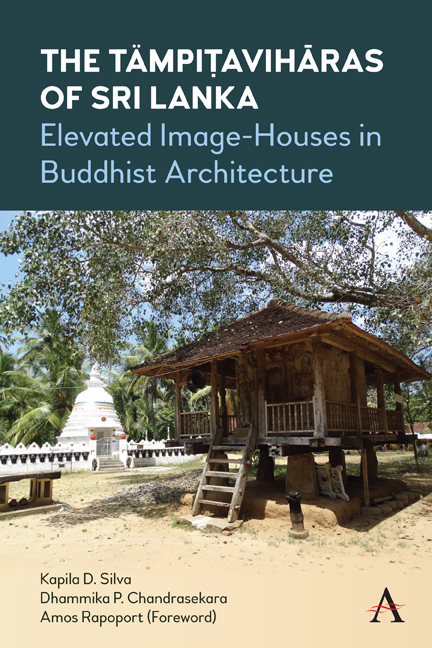North Central Province
Published online by Cambridge University Press: 16 December 2021
Summary
Aḷutdivulvӓva Ṭӓmpiṭavihāra, Anurādhapura District
The Aḷutdivulvӓva temple dates to the Anurādhapura period, possibly to the reign of Vasabha (65– 109 CE), during which time the nearby reservoir was built. The temple premises are on the dam of its namesake reservoir. The ṭämpiṭavihāra was erected in 1744 with the sponsorship of Välipota Kumārihāmi of the Morakǟva Baṇḍāra family of local chieftains. Its four timber beams sit on ten stone pillars, with one pillar added later to support the rear cross beam. There is no balustrade for the ambulatory. Two Buddha images and two figures of deities stand on the sides of the main seated Buddha image. The temple is located 42 km northeast of Käkirāva town in Anurādhapura District, about 8 km east of Galenbiňdunuväva junction, which is on the road connecting Käkirāva to Ganēwalpola-Dacchi-Halmmillǟva.
Ambaräli Ṭӓmpiṭavihāra, Anurādhapura District
While the origins of the temple could be traced to the third century BCE, the ṭämpiṭavihāra was constructed in 1838 under the guidance of Haňdungama Indrajōti Thērō. Painters from the Nīlagama Sittara lineage executed the murals. This is a two-storied ṭämpiṭavihāra, with an extremely narrow ambulatory and a split platform on either side of the central stairway, all located on the upper level. A more spacious ambulatory surrounding the elevated ätulgäba (cella) and a small vestibule under the platforms are constructed on the ground level. These lower level constructions could perhaps be a later addition to the original twostoried image-house. Another rare feature is that the roof ridge runs on the cross axis of the cella, rather than on the longitudinal axis. The ṭämpiṭavihāra is in the Ambaräli Raja Mahā Vihāra, just north of the Hiňguruväva reservoir, about 1 km west of and 23 km north on Kalāväva-Galēwela road from Galēwela town on Kuruṇǟgala-Dambulla road.
Habaraṇa Ṭӓmpiṭavihāra, Anurādhapura District
This ṭämpiṭavihāra was built in the eighteenth century by the local community to honour a Buddhist monk who had impressed King Kīrti Śrī Rājasiṅghe with his virtuous conduct. Elevated on 11 short stone pillars, the ṭämpiṭavihāra has a relatively narrow ambulatory with no handrail. Eight masonry stumps were erected at a later period along the periphery of the ambulatory for additional support.
- Type
- Chapter
- Information
- The Tämpitaviharas of Sri LankaElevated Image-Houses in Buddhist Architecture, pp. 91 - 96Publisher: Anthem PressPrint publication year: 2021



